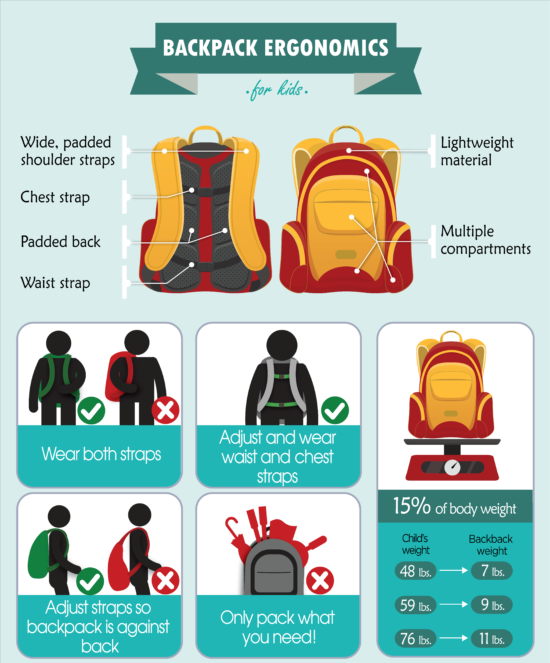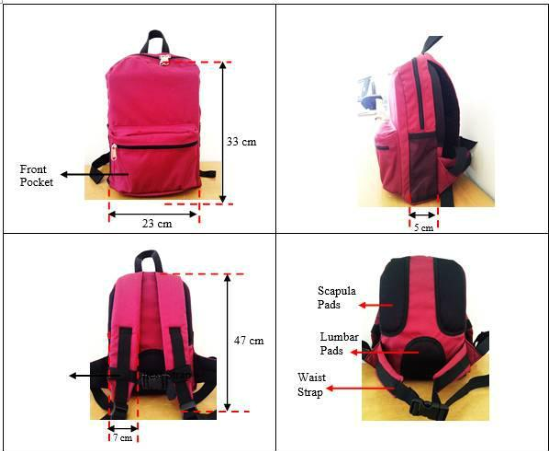In today’s fast-paced world, school students often carry heavy loads of books, notebooks, and supplies daily. However, many students may not realize the potential harm improper backpack use can cause their bodies. This is where the importance of ergonomics in school backpacks becomes evident. Students can safeguard their health and well-being by understanding the principles of ergonomics and choosing the right backpack.
Ergonomics
Ergonomics refers to the study of designing products or systems that interact efficiently and safely with humans. Regarding school backpacks, ergonomics involves creating a design that minimizes strain on the body while providing maximum comfort and support. Ergonomically designed backpacks consider weight distribution, padding, adjustability, and proper fit.
The Importance of Ergonomics in School Backpacks and How to Choose the Right One

Effects of Improper Backpack Use
Using an improperly designed backpack or wearing a backpack incorrectly can lead to various physical and health-related issues. Students who carry heavy loads without proper support may experience back pain, shoulder pain, muscle strain, and poor posture. It can sometimes lead to long-term health issues such as spinal misalignment or chronic pain.
Choosing the Right Backpack
Selecting the right backpack is crucial for maintaining proper ergonomics and minimizing the risk of strain or injury. When choosing a school backpack, there are several factors to consider:
- Size and Capacity: The backpack should be appropriately sized to fit the student’s body and accommodate their belongings without excessive weight.
- Weight Distribution: Look for backpacks that evenly distribute weight across the shoulders and back rather than concentrating on a single point.
- Padding and Support: Opt for backpacks with padded shoulder straps and a back panel to provide cushioning and support.
- Adjustability: Backpacks with adjustable straps and multiple compartments allow for customization and proper fitting.
- Quality and Durability: Choose backpacks made from high-quality materials that can withstand the rigors of daily use.
Ergonomic Features to Look for
To ensure an ergonomic design, consider the following features when selecting a school backpack:
- Ergonomic Shoulder Straps: Wide, padded shoulder straps help distribute weight and reduce shoulder strain.
- Chest and Waist Straps: Backpacks with chest and waist straps help stabilize the load and prevent excessive swinging or shifting.
- Lumbar Support: Some backpacks offer additional padding or lumbar support to promote proper posture and reduce lower back strain.
- Compression Straps: Compression straps allow adjusting the backpack’s volume based on the load, maintaining stability and balance.
- Reflective Materials: Backpacks with reflective elements improve visibility during low-light conditions, enhancing safety.

Proper Backpack Wearing Techniques
Choosing an ergonomic backpack is only half the battle. Students should also learn and practice proper backpack-wearing techniques to maximize the benefits. Here are some tips to consider:
- Pack Light: Only carry the essentials to minimize the weight and strain on your back.
- Use Both Straps: Always use both shoulder straps to distribute weight evenly.
- Adjust the Straps: Ensure the backpack fits snugly against the back, with the bottom resting in the lower back’s curve.
- Pack Strategically: Place heavier items closer to the back and utilize compartments to distribute weight evenly.
- Lift with Care: Bend at the knees when lifting the backpack to minimize strain on the back.
Maintaining a Healthy Backpack Routine
Developing healthy habits and routines related to backpack usage is essential for long-term well-being. Here are some practices to incorporate into a healthy backpack routine:
- Organize and Declutter: Regularly clean the backpack and remove unnecessary items to reduce weight.
- Plan: Pack the backpack the night before to avoid rushing and overloading it in the morning.
- Alternate Carrying Methods: Consider using lockers or leaving unnecessary items at school to reduce the load.
- Take Breaks: If possible, take short breaks during the day to remove the backpack and rest the body.
- Exercise and Stretch: Engage in regular exercise and stretching routines to strengthen muscles and improve flexibility.
Alternatives to Traditional Backpacks
While backpacks are a popular choice for carrying school supplies, alternative options can provide relief and reduce strain. Some alternatives include:
- Rolling Backpacks: Rolling backpacks come with wheels and a retractable handle, allowing students to pull the backpack behind them instead of carrying it on their shoulders.
- Messenger Bags: Messenger bags distribute weight evenly across the body, reducing strain on the shoulders and back.
- Crossbody Bags: Crossbody bags with wide, adjustable straps provide a balanced weight distribution and can be worn across the chest.
- Wheeled Carts: Wheeled carts or trolleys can transport heavier loads, eliminating the need to carry them.
Tips for Parents and Guardians
Parents and guardians play a vital role in ensuring their child’s backpack promotes the Importance of Ergonomics in School Backpacks. Here are some tips for parents and guardians:
- Involve Your Child: Allow your child to participate in the selection process to ensure the backpack fits and meets their needs comfortably.
- Educate Your Child: Teach your child proper backpack-wearing techniques and the importance of maintaining a healthy backpack routine.
- Regularly Inspect the Backpack: Check the backpack for signs of wear and tear and replace it if necessary.
- Communicate with School: Collaborate with the school to ensure students have sufficient time and resources to organize their belongings.
- Encourage Healthy Habits: Promote physical activity, proper posture, and regular breaks to support your child’s well-being.
Understanding the Risks: The Hidden Dangers of a Heavy Backpack
- Increased Risk of Scoliosis: A Curvature of the Spine
- Headaches: The Unwanted Consequence
- Breathing Difficulties: Struggling for Air
- Fatigue: Draining Energy Levels
- Interference with Development: Hindering Growth
Weight Distribution: Achieving Balance and Reducing Strain
- Centralizing the Heaviest Items: Strategic Packing
- Placing Light Items on the Outside: Promoting Stability
- Balancing the Load: Finding the Sweet Spot
- Taking Breaks: Relieving Strain and Promoting Well-being
- Importance of Regular Breaks: Restoring Energy and Circulation
- Recommended Break Frequency: Every 20-30 Minutes
- Stretching and Walking: Rejuvenating the Body and Mind

Conclusion
In conclusion, the importance of ergonomics in school backpacks cannot be overstated. Students can prevent physical strain and potential long-term health issues by selecting the right backpack, practicing proper wearing techniques, and maintaining a healthy backpack routine. Remember, it is essential to prioritize the well-being of students by ensuring they have ergonomic and comfortable backpacks that support their overall health.
FAQs – The Importance of Ergonomics in School Backpacks
Q 1: Can a poorly designed backpack lead to long-term health issues?
A: Yes, using a poorly designed backpack or wearing it incorrectly can lead to long-term health issues such as chronic back pain, muscle strain, and poor posture.
Q 2: How much weight should a student carry in their backpack?
A: As a general guideline, students should carry no more than 10-15% of their body weight in their backpacks to avoid excessive strain.
Q 3: Are rolling backpacks a good alternative to traditional backpacks?
A: Rolling backpacks can be a good alternative for students with difficulty carrying heavy loads. However, they may not be suitable for all environments or terrains.
Q 4: What should I do if my child complains of back pain due to their backpack?
A: If your child complains of back pain, encourage them to lighten their backpack, practice proper wearing techniques, and consider consulting a healthcare professional if the pain persists.
Q 5: How often should I replace my child’s backpack?
A: Inspecting the backpack regularly for signs of wear and tear is recommended. If the backpack shows significant signs of deterioration or no longer provides adequate support, it is time to replace it.
Ameer Hamza is a dedicated fashion writer with a keen eye for emerging trends and a passion for the artistry of style. His work delves into the latest in fashion, offering readers insights on everything from runway-inspired looks to everyday elegance. With a flair for storytelling and a deep understanding of the industry, Ameer Hamza brings a fresh perspective, making high fashion accessible and inspiring to all. Follow along as he explores the intersection of creativity, culture, and couture in the ever-evolving world of fashion.
